Behind the Masks: Dr. Shaheen Shariff, Artist and Academic

iMPACTS is pleased to highlight an exhibit that features art from Dr. Shaheen Shariff, James McGill Professor and iMPACTS Project Director. Below is the description of the masks, as explained by Dr. Shariff.
I have always been fascinated by faces – shields that protect our innermost feelings and present us to the world. Faces that mask our age or show it, through cracks that form over time until it is too difficult to cover them up. Masks that can show or hide joy, fear, love, disappointment, pride, anger, uncertainty, mistrust, or pain. Masks that retain the genetic features of people in places where our ancestors lived and left. Faces can reflect the lives many of us left behind as the result of geo-political conflicts which increase today, as democracy implodes, and autocracy exerts power. Masks that can reflect resilience under harsh patriarchal rules that persist in denying women their rightful place in life and society as intelligent, educated, equal and free human beings.
The medium of clay and Japanese Raku firing process made it possible for me to create masks that take on a life of their own through the glazing and firing process. During this exciting process the artist never knows exactly how the mask will look if it survives. Emerging from a white-hot outdoor kiln, metallic glazes react with the air to trap colors before being reduced in sawdust bins, where the smoke seals iridescent colours. The best part is, that as each mask surfaces, it brings unique wrinkles, cracks and colours that evidence its resilience or weakness through its own journey through the building and firing process, just like human faces that reflect or mask their life experiences.
The masks presented here are part of a collection of approximately 30 that I made over time. Some were sold or hang on people’s walls as gifts. Let me introduce you to them:
- Raku Kenyans: These are the very first Raku masks I made. The cheek on one of them blew off and got stuck on the teacher’s beautiful pot – but she didn’t mind, and he survived without it.
- What Mahsa Amini (Iran) and Hazara Women (Afghanistan) Share: In the last month (September 2022), young people globally have reacted in protest against the arrest and death of Mahsa Amini, a young Kurdish woman for wearing her hijab (headscarf) improperly. Mahsa shares the similar fate of Hazara women who died from a bomb on October 2, 2022 that targeted them for being born in a minority sect of Afghanistan. Women from minority communities in patriarchies suffer intersectional violence for simply being themselves – born as women in visible minority communities. This mask, although I made it at least 15 years ago, continues to reflect the pain and agony of these women today. That is not to say that women in Western societies are always free of violence. In the West, domestic and sexual violence, misogyny and intersectional barriers also affect women’s safety and liberty on a regular basis.
- Hadija: When I was a child, I had an Ethiopian nanny in Kenya called Hadija. She was the most elegant and beautiful woman I had ever seen – tall and regal. This mask reminds me of Hadija. I hope life was kind to her.
- To Mask or Not: Face coverings have often been at the heart of controversies between religion and secularism. Some women have the choice not to wear it but wear it to reflect their identity. Others are forced to wear it. The snake in between them represents authority – that can dictate mandates in different countries and provinces to either wear one for religious reasons or remove it for secular ones. When I created this piece, I never thought it would symbolize yet another kind of mask. One which protected us all during a long pandemic with controversies over mask mandates. The mask in this context has come to mean safety especially for seniors and immune compromised individuals as society opens up again. For others, the mandates were too restrictive on individual freedoms and the right to make choices on how to remain protected. The snake in between them is the virus that continues to lurk in the background.
- The Sun Will Rise Again: This mask, like the others was made at a time when there were fewer threats to global safety. There was no pandemic and no nuclear threat, and climate change had not yet caught up with us, health care was more easily accessible, and travel to see loved ones was much simpler. As life slowly returns to normal after two and a half years of lockdowns there is hope in the air. Although society is at cross-roads where hate and violence seem to proliferate over peace and harmony making it difficult to envision any return to democratic norms, we must not become discouraged. The sun continues to rise every day providing new opportunities for scientific research on climate change; new opportunities to engage youth in spearheading sustainable leadership models for civic responsibility, ethics of care, kindness, compassion, respect for the rule of law and human rights that will hopefully bring global peace. All we can do as individuals and a peaceful community is to do our part.
Dr. Shariff's art exhibit is on display from October 3 to November 30, 2022 at the Baie D’Urfé Library on Lakeshore Road in Baie D’Urfé.




